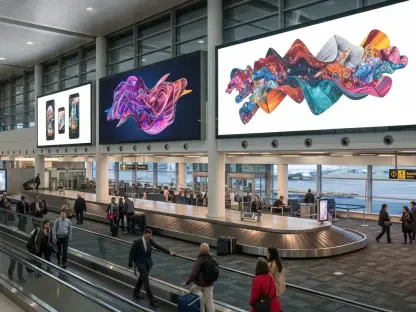In the ever-evolving landscape of digital marketing, Anastasia Braitsik has emerged as a pioneer in the use of generative AI technologies for video ad creation. Her insights have helped transform how brands, especially small and mid-tier ones, approach their marketing strategies. Today, we explore her thoughts on the current trends, challenges, and future outlook of digital video advertising.
How is Generative AI currently being used in digital video ad creation by video buyers?
Generative AI is revolutionizing digital video advertising by enabling video buyers to efficiently create and modify ads. This technology automates the creative process, reducing the need for large production teams and allowing for rapid iteration. It’s particularly useful for brands looking to produce high-quality content quickly and cost-effectively. AI tools are now capable of crafting dynamic ads suited to different audience segments, ultimately leading to more personalized marketing experiences.
What percentage of digital video ads are currently built or modified using GenAI, and how is this expected to change by 2026?
As of now, 30% of digital video ads incorporate GenAI, which is a significant proportion. By 2026, this figure is anticipated to increase to nearly 40%. This growth reflects the industry’s increasing confidence in and reliance on AI technologies to drive creative efficiency and innovation.
Why are small and mid-tier brands particularly drawn to using GenAI for video ads?
Small and mid-tier brands find GenAI attractive because it levels the playing field. It grants them the ability to produce quality video content without the expense of traditional production methods. This democratization of ad creation empowers these brands to compete with larger players without the need for extensive creative teams or hefty budgets.
What are the main ways GenAI is enhancing video ads?
One of the primary ways GenAI enhances video ads is through audience targeting. AI algorithms can analyze consumer data to personalize ad content, ensuring relevance and engagement. Additionally, GenAI enables visual and stylistic modifications, allowing brands to maintain a consistent aesthetic across different platforms. It also improves contextual relevance by using real-time data to tailor messaging that resonates more with viewers.
How are video buyers expecting the sell-side to assist in GenAI creative testing?
Video buyers are increasingly looking for the sell-side to partner with them in GenAI creative testing. They expect robust support systems that include advanced analytics and tools to measure ad performance. This collaboration is crucial for optimizing the creative process and maximizing the effectiveness of AI-generated content.
How is the programmatic CTV landscape changing according to the report?
Programmatic CTV is undergoing a significant transformation, with a marked increase in biddable inventory. This change is driven by a shift towards more automated buying processes and the adoption of enriched targeting capabilities. It’s a dynamic environment where efficiency and precision are becoming the standard expectations from both buyers and sellers.
What are the primary KPIs for CTV programmatic buyers, and why are they important?
For CTV programmatic buyers, improved ROI and ROAS are the most essential KPIs. These metrics provide a clear measure of the effectiveness of ad spend. Additionally, achieving incremental audience reach and utilizing real-time signals are key to ensuring ads are seen by the right consumers at the right time, thus enhancing overall campaign success.
How are buyers approaching live content on streaming platforms differently than traditional linear TV?
Buyers are approaching live content on streaming platforms with higher expectations than they would for traditional TV. They seek features such as real-time interactivity, contextual targeting options, and audience engagement metrics that are not feasible in a linear TV format. This demands advanced technological integration and creative strategies to fully leverage the unique benefits of streaming platforms.
Why is human involvement from the sell-side often necessary for programmatic CTV deals?
Despite the advancements in automation, human involvement is crucial in ensuring that the nuanced elements of programmatic CTV deals are properly managed. Human expertise is often required to tailor solutions to specific campaign goals, resolve technical issues, and provide a personalized touch that technology alone cannot achieve.
How are brands planning to manage self-serve CTV activation platforms?
Brands are increasingly investing in in-house resources to manage self-serve CTV activation platforms. Currently, 74% have either allocated resources or plan to do so, indicating a strong trend towards internal management. This approach allows for greater control over campaigns and more agile decision-making.
Can you describe the methodology behind the IAB’s 2025 Digital Video Ad Spend & Strategy report?
The report draws its data from 368 respondents who either worked at agencies or were brand marketers, each spending a minimum of $1 million on advertising in 2024. This breadth of input provides a comprehensive view of current trends and future projections in the digital video ad space.
As the managing editor of MarTech, how do you perceive the impact of GenAI on digital marketing strategies in general?
Generative AI is a game-changer for the digital marketing landscape. It offers unprecedented opportunities for personalization and efficiency, enabling marketers to craft more effective campaigns with less time and resources. As GenAI continues to evolve, it will undoubtedly drive further innovation in how brands connect with consumers, making marketing strategies more adaptive and customer-centric.
What is your forecast for the future of digital video advertising?
The future of digital video advertising lies in the seamless integration of AI technologies. As these tools become more sophisticated, we’ll see increased automation in creative processes and more dynamic, personalized ad experiences. Brands that embrace these technologies will gain a competitive edge by delivering content that resonates deeply with their audiences, ultimately driving better engagement and conversions.









